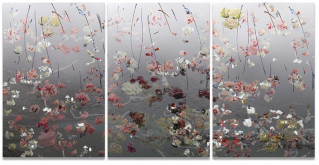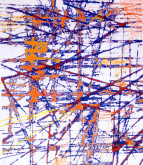
Mathew Choberka, Sounding Board, 2018, digital print on aluminum, 80"x60"

Petra Cortright, Wrestling Entrance Themes_smoke+the_weed+mp3, 2018, digital triptych painting on anodized aluminum, 73"x48"

Chris Dorland, Untitled (Apache Struts) , 2017, UV ink on Alumacore, 94"x46"

Lucas Martell, Light Weight , 2018, digital print and paint, canvas, 96"x72"

John Pomara, Red Alert (nude 1), 2018, UV pigment ink on canvas, 108"x72"

Lorraine Tady, Octagon Vibration Series, Frequency Piccadilly Circus, 2019, UV ink, canvas, 96"x84"

Dean Terry, Suburban White Woman #1, 2018, digital ink and graphite, aluminum, 120"x60"

Liz Trosper, Accumulation 2, 2018, UV pigment ink, canvas, 96"x76"

Zeke Williams, Klymene, 2018, archival inkjet, canvas, 108"x84"





















